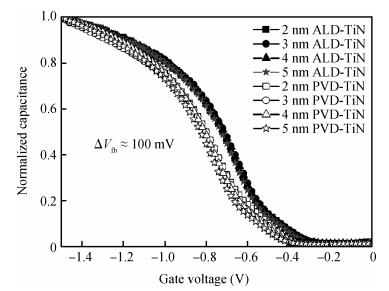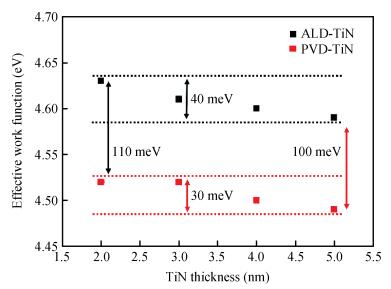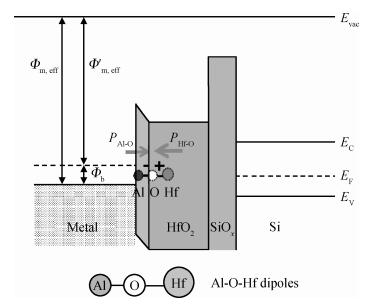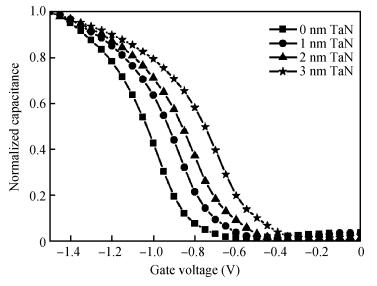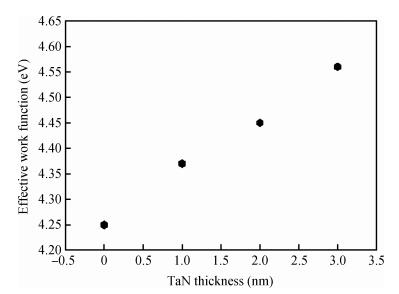| Citation: |
Xueli Ma, Hong Yang, Wenwu Wang, Huaxiang Yin, Huilong Zhu, Chao Zhao, Dapeng Chen, Tianchun Ye. The effects of process condition of Top-TiN and TaN thickness on the effective work function of MOSCAP with high-k/metal gate stacks[J]. Journal of Semiconductors, 2014, 35(10): 106002. doi: 10.1088/1674-4926/35/10/106002
****
X L Ma, H Yang, W W Wang, H X Yin, H L Zhu, C Zhao, D P Chen, T C Ye. The effects of process condition of Top-TiN and TaN thickness on the effective work function of MOSCAP with high-k/metal gate stacks[J]. J. Semicond., 2014, 35(10): 106002. doi: 10.1088/1674-4926/35/10/106002.
|
The effects of process condition of Top-TiN and TaN thickness on the effective work function of MOSCAP with high-k/metal gate stacks
DOI: 10.1088/1674-4926/35/10/106002
More Information
-
Abstract
We introduced a TaN/TiAl/top-TiN triple-layer to modulate the effective work function of a TiN-based metal gate stack by varying the TaN thickness and top-TiN technology process. The results show that a thinner TaN and PVD-process top-TiN capping provide smaller effective work function (EWF), and a thicker TaN and ALD-process top-TiN capping provides a larger EWF; here, the EWF shifts are from 4.25 to 4.56 eV. A physical understanding of the dependence of the EWF on the top-TiN technology process and TaN thickness is proposed. Compared with PVD-TiN room temperature process, the ALD-TiN 400℃ process provides more thermal budget. It would also promote more Al atoms to diffuse into the top-TiN rather than the bottom-TiN. Meanwhile, the thicker TaN prevents the Al atoms diffusing into the bottom-TiN. These facts induce the EWF to increase.-
Keywords:
- TaN,
- ALD-TiN,
- PVD-TiN,
- effective work function
-
References
[1] Hu J C, Yang H, Kraft R, et al. Feasibility of using W/TiN as metal gate for conventional 0.13μm CMOS technology and beyond. Proceedings of IEEE International Electron Devices Meeting, 1997:825[2] Hobbs C, Fonseca L, Dhandapani V, et al. Fermi Level pinning at the polySi/metal oxide interface. Proceedings of VLSI Technology Symposium, 2003:9[3] Chang L, Tang S, King T, et al. Gate length scaling and threshold voltage control of double-gate MOSFETs. Proceedings of IEEE International Electron Devices Meeting, 2000:719[4] Choi K, Wen H C, Alshareef H, et al. The effect of metal thickness, overlayer and high-k surface treatment on the effective work function of metal electrode. Proceedings of European Solid-State Device Research Conference, Grenoble, 2005:101[5] Kesapragada S, Wang R, Liu D, et al. High-k/metal gate stacks in gate first and replacement gate schemes. Proceedings of Advanced Semiconductor Manufacturing Conference, 2010:256 http://ieeexplore.ieee.org/document/5551460/[6] Heo S C, Choi C. Plasma atomic layer deposited TiN metal gate for three dimensional device applications:deposition temperature, capping metal and post annealing. Microelectron Eng, 2012, 94:11 doi: 10.1016/j.mee.2011.12.001[7] Lee S H, Choi R, Choi C. Effects of composition and thickness of TiN metal gate on the equivalent oxide thickness and flat-band voltage in metal oxide semiconductor devices. Microelectron Eng, 2013, 109:160 doi: 10.1016/j.mee.2013.03.056[8] [9] Xiong K, Robertson J, Pourtois G, et al. Impact of incorporated Al on the TiN/HfO2 interface effective work function. J Appl Phys, 2008, 104:074501 doi: 10.1063/1.2986158[10] Arimura H, Haight R, Brown S L, et al. Temperature-dependent La-and Al-induced dipole behavior monitored by femtosecond pump/probe photoelectron spectroscopy. Appl Phys Lett, 2010, 96:132902 doi: 10.1063/1.3374883[11] Yang Z C, Huang A P, Yan L, et al. Role of interface dipole in metal gate/high-k effective work function modulation by aluminum incorporation. Appl Phys Lett, 2009, 94:252905 doi: 10.1063/1.3159830[12] Haruhiko T, Hiroshi M, Yusuke M, et al. Ti-capping technique as a breakthrough for achieving low threshold voltage, high mobility, and high reliability of pMOSFET with metal gate and high-k dielectrics technologies. Proceedings of IEEE International Electron Devices Meeting, 2009:427 -
Proportional views





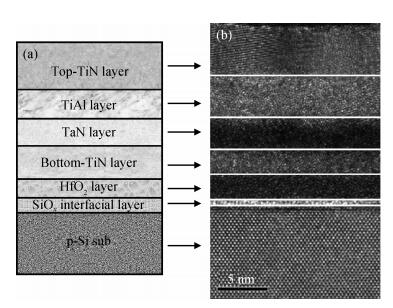
 DownLoad:
DownLoad:
